Eat Your Words The definitive dictionary for the discerning diner Paul Convery  Mango Publishing Coral Gables Copyright 2019 Paul Convery Published by Mango Publishing, a division of Mango Media Inc. Cover Design: Jermaine Lau
Mango Publishing Coral Gables Copyright 2019 Paul Convery Published by Mango Publishing, a division of Mango Media Inc. Cover Design: Jermaine Lau
Layout Design: Jermaine Lau
Shutterstock: DiviArt Mango is an active supporter of authors rights to free speech and artistic expression in their books. The purpose of copyright is to encourage authors to produce exceptional works that enrich our culture and our open society. Uploading or distributing photos, scans or any content from this book without prior permission is theft of the authors intellectual property. Please honor the authors work as you would your own. Thank you in advance for respecting our authors rights.
For permission requests, please contact the publisher at: Mango Publishing Group
2850 Douglas Road, 2nd Floor
Coral Gables, FL 33134 USA
For special orders, quantity sales, course adoptions and corporate sales, please email the publisher at .
For trade and wholesale sales, please contact Ingram Publisher Services at
or +1.800.509.4887. Eat Your Words: The Definitive Dictionary for the Discerning Diner Library of Congress Cataloging
ISBN: (p) 978-1-64250-134-6 (e) 978-1-64250-135-3 BISAC: CKB071000 COOKING / Reference LCCN: 2019948611 Printed in the United States of America For eatymologists, bibliophagists, and
verbivores everywhere Table of Contents Tasting Notes: Flavour, Freshness
(and So Forth) Welcome to Eat Your Words the most gloriously gluttonous glossary of all things grub and gastronomy. An advanced alimentary vocabulary for bon viveurs and verbivores alike , Eat Your Words brings to the table a cordon bleu compilation of six thousand often unusual and unfamiliar terms across twenty-one fact-packed courses, offering the reader a unique feast of learning as well as a fun and flavour-filled dip into the fascinating language of food and eating. Anyone with a hunger for weird and wonderful words, or simply consumed with curiosity about the wider world of cooking and cuisine, will assuredly find something to savour and devour on every page of this richly satisfying read and indispensable reference work. This is the one dictionary you will always be glad you swallowed. Spice up your lex life with a banquet of recondite and recherch words sure to make your mouth waterfrom abligurition, abrosia and abyrtaca to zomotherapeutics, zoosaprophagy and zuuzuus & whamwhams.
Do you know the difference between macaroni and macaroon , macadamia and macedoine , madeleine and madriln e ? What about mazagan, mazamorra and mazzard ? All are items of food, and more manna than maw-wallop to the magirologist . Mind and apply your masticators to the manducation of said fare, or you may get maldigestion . And always consume in moderation, lest you bloat with the girth of a macrogaster . When would you use a frixory or a furcifer , and where would you find a boar-frank or a broilerhouse ? What would you buy from an oporopolist or an opsonator , and whom would you meet at a parrillada or a poggle-khana ? Why would you calver or caveach , concasse or consewe ? How does your fave plate taste: saccharaceous, salsamentarious, subacidulous ? Find out insideand prepare to dazzle family, friends and all the foodies you know with your effortless eatymological erudition. Eat Your Words is no standard, straight-through A to Z, however. It is, rather, the first work to showcase the terminology of food, cookery, and stomach-stuffing across a number of discrete subject areas, covering curious meals from far and wide and their many intriguing ingredients, the craft and artifice of the culinarian, food science and technology, diet and appetite, the catering trade, dining in and out, the pleasures of the palate, and so much more besides.
The result is a specially themed and structured encyclofeedia no word buff, food lover or good writer will want to be without. Heres whats on the menu. Our starter section, Of Flora, Fauna, & Food, addresses the very substance and source of food itself. Chapter 1 treats of food groups and food in the general senseclasses and categories, qualities and quantities. Chapters 2 and 3 provide a modest inventory from the myriad basic stuffs and staples found across the plant and animal kingdoms, respectively, alongside some of the many primary food products humankind has derived therefrom. Finally, Chapter 4 deals with food production, processing, and provisionfrom primitive hunting and harvesting to early agriculture and animal husbandry to modern farms, fisheries and factories.
The following section, Dainty Dishes & Choice Cuisine, then presents a smorgasbord of the finest prepared fare anywhere for the readers delectation. Chapter 5 offers a generous serving of old concoctions and odd confections from the good kitchens of the Anglosphere. This is complemented in Chapter 6 by a wide selection of delicacies honouring the culinary traditions and diverse cuisines of communities across all four corners of planet Earth. Our next main section asks, Whats Cooking? Chapter 7 answers by way of a comprehensive digest of cooks and chefs, domestic and professional alike, along with a treasury of tips, tricks, and techniques used in the kitchen. Chapter 8, meantime, considers the properties and particularities of foods both fair and foul, itemizing the different tastes, textures, and so forth of the multitudinous victuals and viands cooked and eaten by man. By way of a side, Something to Digest shifts our lexical focus away from cookery and cuisine onto consumption and chemistry.
Chapter 9 is devoted to matters pertaining not to what, but rather to how we eat and digest, cataloguing the full gamut of gastric processesand problemsrunning from gob through gullet to gut. The themes of nourishment and human dietary health are developed further as Chapter 10 delves into the language of food science and safety. You Are What You Eat examines our eating habits both good and bad, listing the wealth of dietary choices and lifestyles commonly available today (Chapter 11) and, contrariwise, those cravings best considered downright crazy or depraved (Chapter 12). As an accompaniment to the above, the feeding practices and preferences of assorted vores, trophs, and phages across the natural world are also classified (Chapter 13). Our subsequent courses enjoin you, dear reader, to Whet Your Appetite. Moving swiftly from feast to fast to famine, Chapter 14 expresses the lexicon of gluttony and excess, Chapter 15 explores the idiom of aversion and disgust, while Chapter 16 outlines the language of hunger and want.
The penultimate section, Catering for Every Taste, looks at the vocabulary of provisioning and purveyingcovering the retail and restaurant trades, merchants and markets, food stores and eating establishments (Chapter 17)before kitting out the kitchen and setting the table , checklisting the profusion of utensils and utilities used internationally in the several acts of cooking, serving, and eating (Chapter 18). We round our wordfest off with an invitation to Come Dine with Me. Here, we take an all-inclusive lexical tour of dinners, the fine dining experience, and finally diners themselves. Chapter 19 dishes up a gallimaufry of meals and mealtimes, light bites and courses, and occasions for feeding and feasting. Chapter 20 embraces eating matters and manners and all things epicureanencompassing the faculty of (good) taste, the gratifications of gastronomy, and popular food philias and phobias. In closing, in Chapter 21 we consider ourselves: presenting a veritable thesaurus of trencher folk of every stripegourmets and gourmandisers, foodists and faddists, buzguts and belly-gods all.
All entries have been carefully selected from the most exhaustive unabridged dictionaries and extensive word troves available, as well as a wide range of specialist resources and learned monographs in both print and digital formats. There is no scholarly apparatusparts of speech, variant spellings, etymologies or phoneticsto burden the text. The entries are defined in the compilers own words with economy of expression and ease of comprehension foremost in mind, seasoned with the occasional dash of wit. Any errors are his and his alone; in keeping with the spirit of the book, he humbly pledges to eat his own words in such event. So, why not expand your vocabulary and not your waistline by taking a hearty bite from Eat Your Words: The Definitive Dictionary for the Discerning Diner. Bon apptit.
Next page
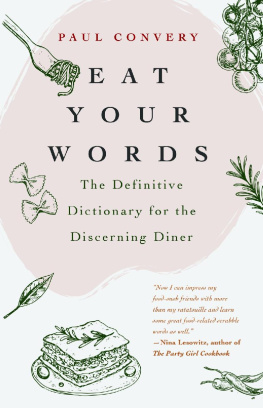

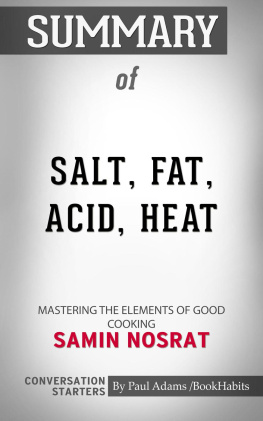


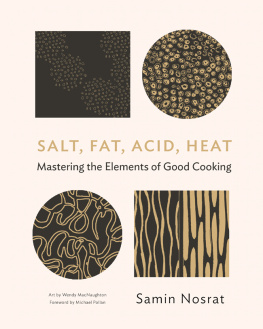
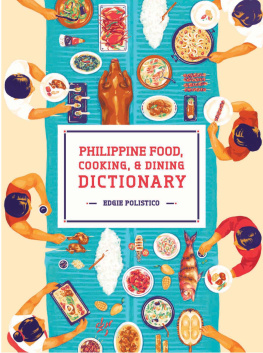




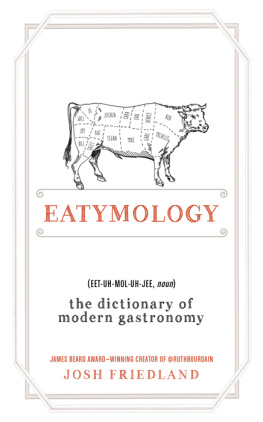
 Mango Publishing Coral Gables Copyright 2019 Paul Convery Published by Mango Publishing, a division of Mango Media Inc. Cover Design: Jermaine Lau
Mango Publishing Coral Gables Copyright 2019 Paul Convery Published by Mango Publishing, a division of Mango Media Inc. Cover Design: Jermaine Lau